
Mu Cephei, also known as Herschel's Garnet Star, Erakis, or HD 206936, is a red supergiant or hypergiant star in the constellation Cepheus. It appears garnet red and is located at the edge of the IC 1396 nebula. Since 1943, the spectrum of this star has served as a spectral standard by which other stars are classified.

Delta Cephei is the Bayer designation for a quadruple star system located approximately 887 light-years away in the northern constellation of Cepheus, the King. At this distance, the visual magnitude of the star is diminished by 0.23 as a result of extinction caused by gas and dust along the line of sight. It is the prototype of the Cepheid variable stars that undergo periodic changes in luminosity.
Beta Cephei variables, also known as Beta Canis Majoris stars, are variable stars that exhibit small rapid variations in their brightness due to pulsations of the stars' surfaces, thought due to the unusual properties of iron at temperatures of 200,000 K in their interiors. These stars are usually hot blue-white stars of spectral class B and should not be confused with Cepheid variables, which are named after Delta Cephei and are luminous supergiant stars.

Iota Canis Majoris, Latinized from ι Canis Majoris, is a solitary variable supergiant star in the southern constellation of Canis Major. It is visible to the naked eye with an apparent visual magnitude that varies between +4.36 and +4.40. The distance to this star is approximately 3,100 light years based on parallax measurements. It is drifting further away with a radial velocity of +41.2 km/s.

27 Canis Majoris is a binary star system in the northern constellation of Canis Major, located approximately 1,700 light years away from the Sun. It has the variable star designation EW Canis Majoris; 27 Canis Majoris is the Flamsteed designation. This system is visible to the naked eye as a dim, blue-white hued star with an apparent visual magnitude of +4.65. It is moving away from the Earth with a heliocentric radial velocity of 16 km/s.

VV Cephei, also known as HD 208816, is an eclipsing binary star system located in the constellation Cepheus, approximately 5,000 light years from Earth. It is both a B[e] star and shell star.
KW Sagittarii is a red supergiant, located approximately 1,900 parsecs away from the Sun in the direction of the constellation Sagittarius. It is one of the largest-known stars. If placed at the center of the Solar System, the star's surface would engulf Mars.

V354 Cephei is a red supergiant star located within the Milky Way. It is an irregular variable located over 8,900 light-years away from the Sun. It has an estimated radius of 685 solar radii. If it were placed in the center of the Solar System, it would extend to between the orbits of Mars and Jupiter.

Zeta Cephei is a star in the constellation of Cepheus. Zeta Cephei marks the left shoulder of Cepheus, the King of Joppa (Ethiopia). It is one of the fundamental stars of the MK spectral sequence, defined as type K1.5 Ib.

Epsilon Persei, Latinized from ε Persei, is a multiple star system in the northern constellation of Perseus. It has a combined apparent visual magnitude of +2.88, which is bright enough to be viewed with the naked eye. Based upon parallax measurements, this system is located at a distance of roughly 640 light-years (196 parsecs) from Earth.
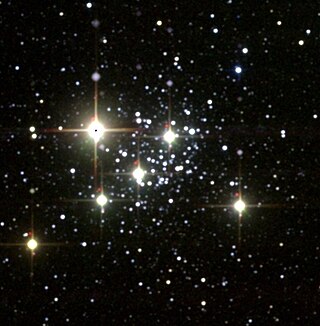
MY Cephei is a red supergiant located in open cluster NGC 7419 in the constellation of Cepheus. It is a semiregular variable star with a maximum brightness of magnitude 14.4 and a minimum of magnitude 15.5.
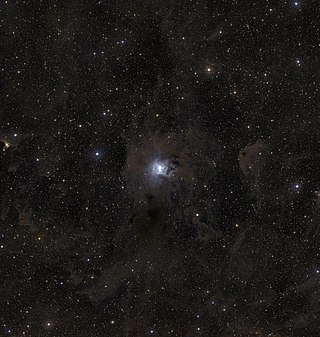
T Cephei is a Mira variable star in the constellation Cepheus. Located approximately 600 light-years distant, it varies between magnitudes 5.2 and 11.3 over a period of around 388 days.
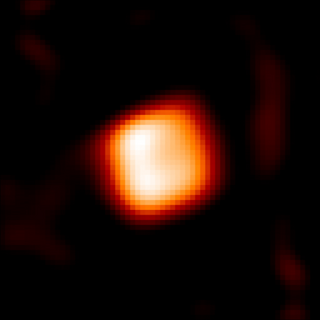
RW Cephei is a K-type hypergiant and a semirregular variable star in the constellation Cepheus, at the edge of the Sharpless 132 H II region and close to the small open cluster Berkeley 94. It is among the largest stars known with a radius of almost 1,000 times that of the Sun (R☉), nearly as large as the orbit of Jupiter.

A hypergiant (luminosity class 0 or Ia+) is a very rare type of star that has an extremely high luminosity, mass, size and mass loss because of its extreme stellar winds. The term hypergiant is defined as luminosity class 0 (zero) in the MKK system. However, this is rarely seen in literature or in published spectral classifications, except for specific well-defined groups such as the yellow hypergiants, RSG (red supergiants), or blue B(e) supergiants with emission spectra. More commonly, hypergiants are classed as Ia-0 or Ia+, but red supergiants are rarely assigned these spectral classifications. Astronomers are interested in these stars because they relate to understanding stellar evolution, especially star formation, stability, and their expected demise as supernovae.

Classical Cepheids are a type of Cepheid variable star. They are young, population I variable stars that exhibit regular radial pulsations with periods of a few days to a few weeks and visual amplitudes ranging from a few tenths of a magnitude up to about 2 magnitudes. Classical Cepheids are also known as Population I Cepheids, Type I Cepheids, and Delta Cepheid variables.
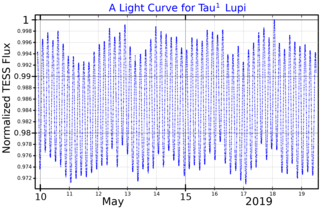
Tau1 Lupi, Latinized from τ1 Lupi, is a solitary star in the southern constellation of Lupus. It is visible to the naked eye with an apparent visual magnitude of 4.5. Based upon an annual parallax shift of only 2.99 mas as seen from Earth, it is located about 1,090 light years from the Sun. Tau1 Lupi may be a runaway star having a peculiar velocity of 32.6±3.6 km/s. It is a member of the Upper Centaurus–Lupus sub-group of the nearby Sco OB2 association.

V419 Cephei is an irregular variable star in the constellation of Cepheus with an apparent magnitude that varies between 6.54 and 6.89.

NGC 7419 is an open cluster in the constellation Cepheus. It is heavily reddened and notable for containing five red supergiants, the highest number known in any cluster until the end of the 20th century, but probably no blue supergiants.

12 Lacertae is a wide binary star system in the northern constellation of Lacerta, located roughly 1,260 light years away from the Sun based on parallax. It is visible to the naked eye as a dim, blue-white hued point of light with a baseline apparent visual magnitude of 5.23. The system is drifting closer to the Earth with a mean heliocentric radial velocity of –12.5. It is a probable member of the I Lacertae OB association.
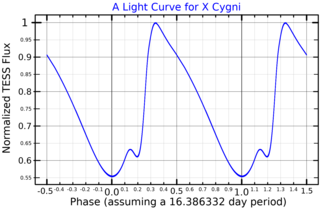
X Cygni is a variable star in the northern constellation of Cygnus, abbreviated X Cyg. This is a Delta Cephei variable that ranges in brightness from an apparent visual magnitude of 5.85 down to 6.91 with a period of 16.386332 days. At it brightest, this star is dimly visible to the naked eye. The distance to this star is approximately 628 light years based on parallax measurements. It is drifting further away with a radial velocity of 8.1 km/s. This star is a likely member of the open cluster Ruprecht 173.














